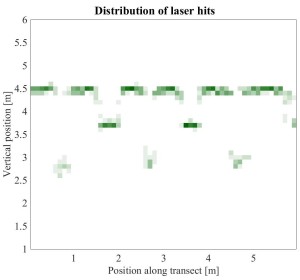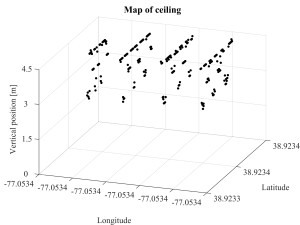During this past AmeriFlux PI Meeting, Gil Bohrer and Tim Morin presented a live demonstration of their Portable Canopy Lidar (PCL), shown in Figure 1, which was developed by their team. The system is based on Lidar (light detection and ranging), which uses pulsed laser light to measure distances based on “time-of-flight.” In the demo, Tim put on the harness with Lidar, and scanned the ceiling of the conference room, capturing features from both the flat surfaces in the background and the chandeliers while doing transect walks (Figure 2).
The results from the scans are shown in Figure 3 for a single transect and Figure 4 showing all the points.
The people involved in the development of the PCL unit are:
- Gil Bohrer (Ohio State University)
- Peter Curtis (Ohio State University)
- Alex Fotis (Ohio State University)
- Chris Gough (Virginia Commonwealth)
- Brady Hardiman (Boston University)
- Tim Morin (Ohio State University)
- Chris Vogel (University of Michigan)
Publications from the group using the equipment to characterize canopy structural features include:
- S. Hardiman, G. Bohrer, C. M. Gough, P. S. Curtis. Canopy Structural Changes Following Widespread Mortality of Canopy Dominant Trees. Forests. 2013, 4(3):537-552.
- S. Hardiman, C. M. Gough, A. Halperin, K. L. Hofmeister, L. E. Nave, G. Bohrer, P. S. Curtis. Maintaining high rates of carbon storage in old forests: A mechanism linking canopy structure to forest function. Forest Ecology and Management. 2013, 298:111-119.
- S. Hardiman, G. Bohrer, C. M. Gough, C. S. Vogel, P. S. Curtis. The role of canopy structural complexity in wood net primary production of a maturing northern deciduous forest. Ecology. 2011, 92(9):1818-1827.
Their Lidar system is based on an original design by Jess Parker (Smithsonian Environmental Research Center):
- G. G. Parker, D. J. Harding, M. L. Berger. A portable LIDAR system for rapid determination of forest canopy structure. Journal of Applied Ecology. 2004, 41(4): 755-767
Photographs (Figures 1 and 2) by Marilyn Saarni. Plots (Figures 3 and 4) by Tim Morin.





No Comments
Be the first to start a conversation